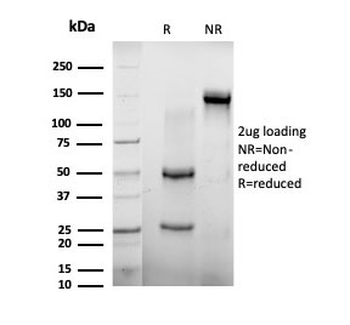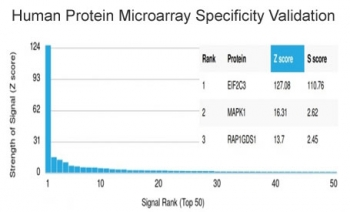You have no items in your shopping cart.
AGO3 Antibody / Argonaute-3 / eIF2C3
Catalog Number: orb1151454
| Catalog Number | orb1151454 |
|---|---|
| Category | Antibodies |
| Description | Mouse monoclonal antibody to AGO3 |
| Species/Host | Mouse |
| Clonality | Monoclonal |
| Clone Number | PCRP-AGO3-1C5 |
| Tested applications | ELISA, FACS, IF |
| Reactivity | Human |
| Isotype | Mouse IgG1, kappa |
| Immunogen | Recombinant full-length human AGO3 protein was used as the immunogen for the AGO3 antibody. |
| Antibody Type | Primary Antibody |
| Dilution range | ELISA (order BSA-free format for coating),Flow cytometry: 1-2ug/million cells,Immunofluorescence: 1-2ug/ml |
| Purity | Protein A/G affinity |
| Conjugation | Unconjugated |
| Formula | 0.2 mg/ml in 1X PBS with 0.1 mg/ml BSA (US sourced), 0.05% sodium azide |
| Hazard Information | This AGO3 antibody is available for research use only. |
| UniProt ID | Q9H9G7 |
| Storage | Aliquot the AGO3 antibody and store frozen at -20°C or colder. Avoid repeated freeze-thaw cycles. |
| Buffer/Preservatives | 0.2 mg/ml in 1X PBS with 0.1 mg/ml rAlbumin (US sourced), 0.05% sodium azide |
| Note | For research use only |
| Application notes | Optimal dilution of the AGO3 antibody should be determined by the researcher. |
| Expiration Date | 12 months from date of receipt. |

FACS staining of PFA-fixed human HeLa cells with AGO3 antibody (blue, clone PCRP-AGO3-1C5) and isotype control (red).
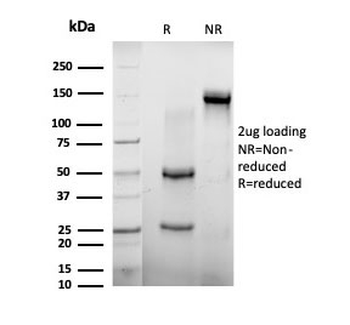
SDS-PAGE analysis of purified, BSA-free AGO3 antibody (clone PCRP-AGO3-1C5) as confirmation of integrity and purity.
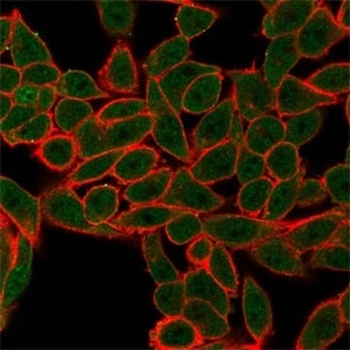
Immunofluorescent staining of PFA-fixed human HeLa cells. Cytoplasmic P-bodies and nucleoplasm show staining with AGO3 antibody (green, clone PCRP-AGO3-1C5), and phalloidin counterstain (red).
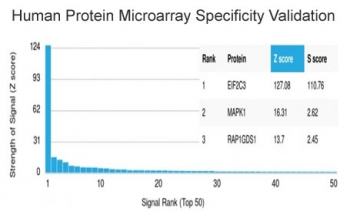
Analysis of HuProt (TM) microarray containing more than 19000 full-length human proteins using AGO3 antibody (clone PCRP-AGO3-1C5). These results demonstrate the foremost specificity of the PCRP-AGO3-1C5 mAb. Z- and S- score: The Z-score represents the strength of a signal that an antibody (in combination with a fluorescently-tagged anti-IgG secondary Ab) produces when binding to a particular protein on the HuProt (TM) array. Z-scores are described in units of standard deviations (SD's) above the mean value of all signals generated on that array. If the targets on the HuProt (TM) are arranged in descending order of the Z-score, the S-score is the difference (also in units of SD's) between the Z-scores. The S-score therefore represents the relative target specificity of an Ab to its intended target.
AGO3 Antibody / Argonaute-3 / eIF2C3 [orb2636539]
ELISA, FACS, IF
Human
Mouse
Monoclonal
Unconjugated
20 μg




